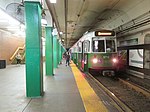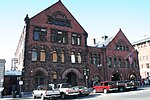Berklee Performance Center
1972 establishments in MassachusettsTheatres in Boston

The Berklee Performance Center is a 1,215-seat theatre located on Massachusetts Ave. in the Back Bay area of Boston, Massachusetts. It is the largest theatre space on the Berklee College of Music campus and is used primarily for college-affiliated activities. Presenters from outside the Berklee community also rent it for performances of all kinds. In 2009, the Berklee Performance Center hosted a total of 200 events.
Excerpt from the Wikipedia article Berklee Performance Center (License: CC BY-SA 3.0, Authors, Images).Berklee Performance Center
Massachusetts Avenue, Boston Fenway / Kenmore
Geographical coordinates (GPS) Address Nearby Places Show on map
Geographical coordinates (GPS)
| Latitude | Longitude |
|---|---|
| N 42.347016666667 ° | E -71.087572222222 ° |
Address
Massachusetts Avenue 130-134
02115 Boston, Fenway / Kenmore
Massachusetts, United States
Open on Google Maps






